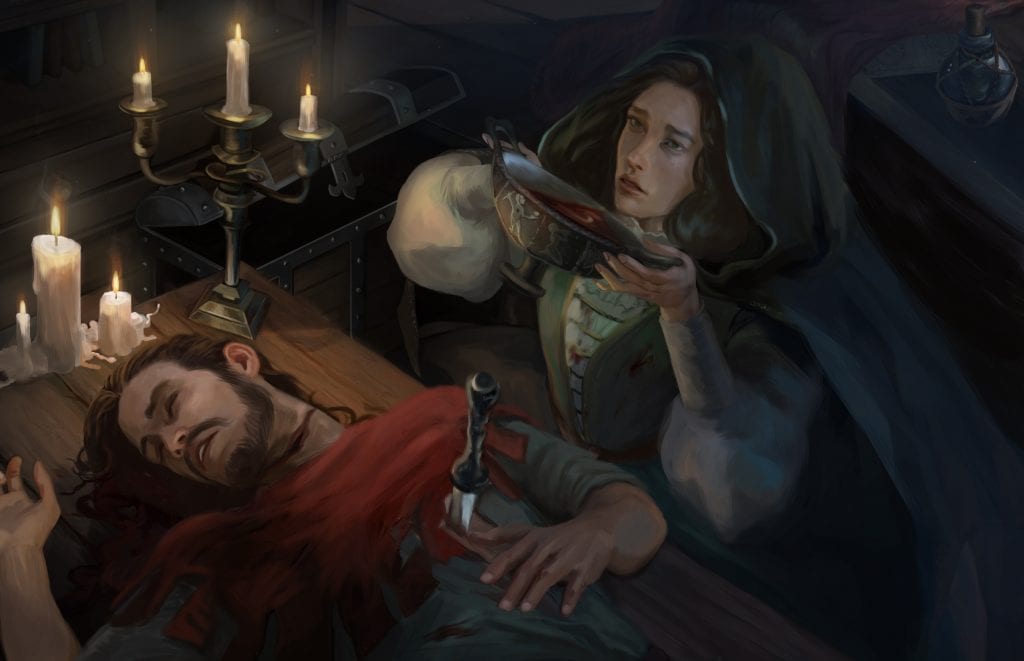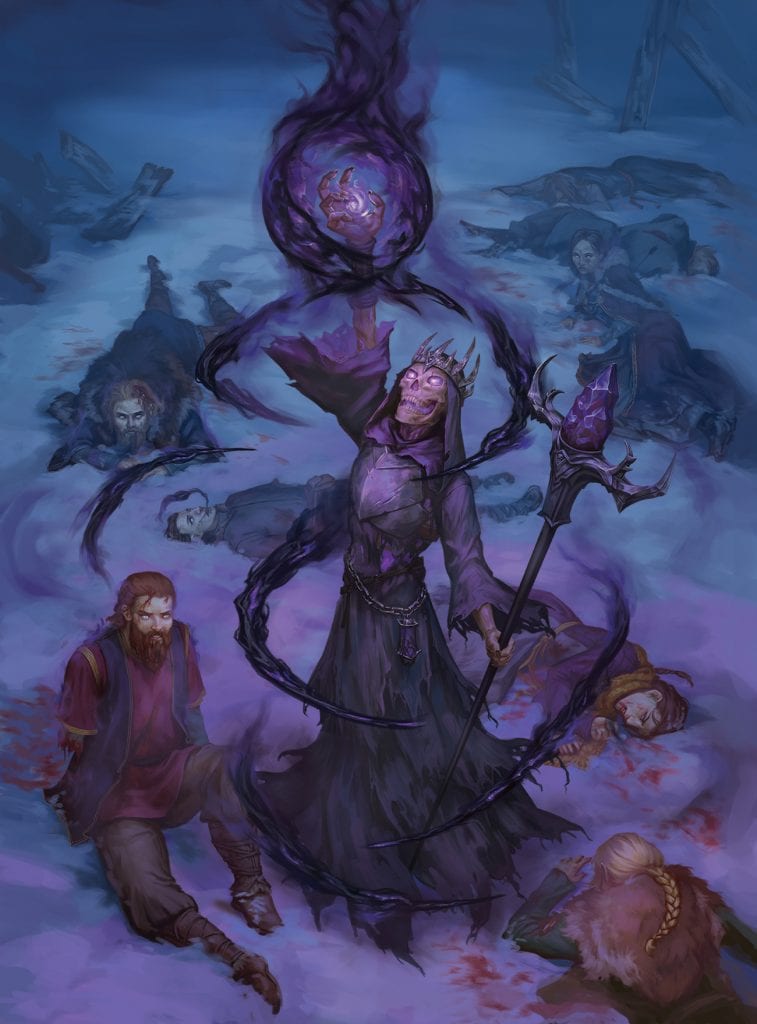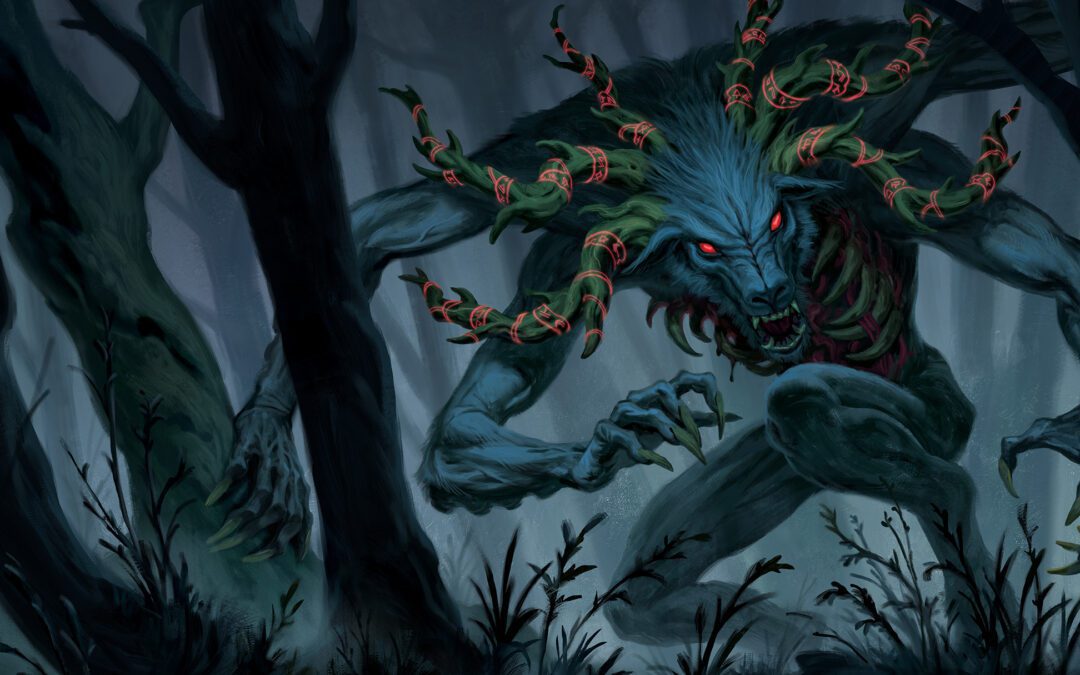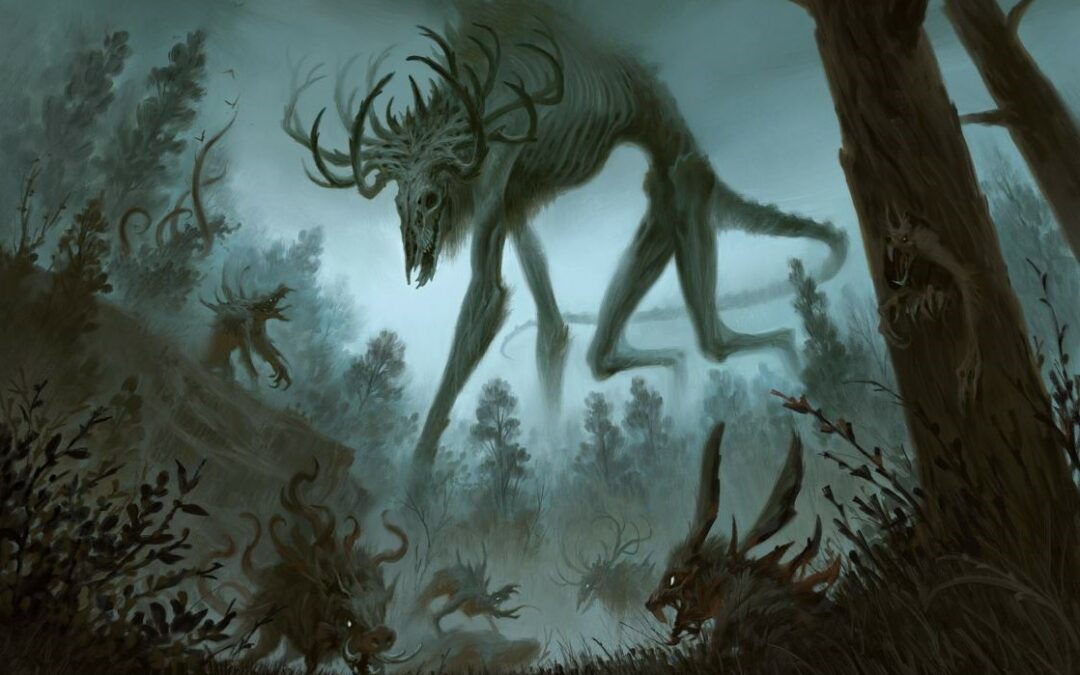
Welcome to this nefarious new blog series! Throughout a course of five articles, we’ll be chatting about the need-to-knows of building and running evil campaigns for 5th edition! So, get out your skull jewellery and patent leather capes because we’re in for a wicked ride.
What is an evil campaign?
For those of you new to the idea of an evil campaign, let’s break down exactly what we’re going to be talking about in this blog series, the fabled evil campaign. Essentially an evil campaign works like any other, except that all of the player characters are evil-aligned. Most GMs at some point or another have thought about running an evil campaign, but while the mechanics might look the same on paper, the actual practice of handling a group of evil characters is a true challenge. Successfully building and maintaining an evil campaign requires a lot of skill and a lot of legwork since D&D resources aren’t typically tailored to support such a different narrative. Most products out there assume that characters will go on adventures because ‘it’s the right thing to do,’ which honestly doesn’t cut it for evil characters.
Grim Hollow Evil Campaigns
If you are building a campaign using Grim Hollow, then you are likely already familiar with elements of an evil campaign. If you have players who aspire to transform into aberrant horrors, liches, and vampires, then you have the beginnings of an evil campaign on your hands already. If you have such players and are interested in using the options provided in the book, you might want to consider an evil campaign! Running an entire party of evil characters is often easier than running a standard heroic party with just one evil character.
Why run an evil campaign?
We’ve mentioned that running an evil campaign is more complicated, so why would we do it? Well, for starters, playing evil characters gives you a very different narrative experience. In today’s zany zeitgeist, we see more and more stories championing characters who are different, whether that means monstrous, misunderstood, or just plain anarchistic. Modern culture has fallen in love with the story of ‘the other .’ A chance to portray such characters is often synonymous with playing characters typically considered ‘evil’ in the limited moral scope baked into fantasy roleplaying games.
Besides the appeal of playing totally different kinds of characters, evil campaigns allow us to tell different types of stories. The stakes and consequences present in evil campaigns are different from those in most games. A party of evil adventurers might also seek to stop an apocalypse, but probably only so they can do the apocalypse their way at a later date. In an evil campaign, incinerating an entire city to resurrect a god isn’t an unspeakable act but rather an interesting challenge. In this way, creating adventures, encounters, and story arcs that appeal to different persuasions is as novel an experience for the GM as player characters.

Artist: Tijana Janković
Where to start?
So, let’s say we’ve convinced you. You’re all ready to start an evil campaign. But where the heck do you begin building such a radical experience? First and foremost, you need to assemble an enthusiastic group and plan a session 0. Both these things are necessary to create a successful evil campaign, and a game without them is doomed to be dead on arrival.
- An enthusiastic group is a GM and a group of players who are on board to play an evil campaign, and a group of people willing to work a little harder than average to have a successful game. The flat-out truth is that many players are either not suited or not willing to handle playing an evil character responsibly, which is totally okay. Players who aren’t enthusiastic about playing evil characters, players who are brand new to roleplaying, or players who won’t respect boundaries are not good candidates for an evil campaign.
- Planning a session 0 is an absolute must for an evil campaign. There are a lot of great resources online about how to successfully plan a session 0 (in case you aren’t familiar with the term), they are invaluable tools for navigating the experience. Evil campaigns frequently delve into dark themes, moral quandaries, and frightening material, and therefore need strict boundaries and frequent group dialogue. Session 0 is necessary to establish safety parameters and discuss themes that are or are not acceptable in your game. It is also essential to figure out how the heck your evil characters are supposed to work together in the world’s fiction (you know, without maiming each other). It is also necessary to establish what kind of evil campaign you all want to play because, as any evil character will tell you, there are many shades of grey to consider.
Getting Consent
Evil games inherently deal with dark themes, so all participating players must decide on hard and soft limits for what can appear in the game. Every single player should consider and share what lines they are not willing to cross in gameplay, and these rules should be revisited frequently. People might be okay with generic horror movies, but not slasher films. Axe murderers might be okay, but not serial killers, etc. Never assume. Always maintain an open dialogue. And if you discover someone in your group isn’t willing to discuss table safety during your session 0, that is an excellent indication they won’t be a fit for an evil campaign. As we mentioned, there are a lot of great free online resources available to prepare you for running a session 0, but here are some basic content and themes you should discuss whether to include or not in the game:
- Descriptions of physical violence
- Themes of mental and physical health
- Real-world religion and fantasy portrayal based on real-world religions
- Representing analogs real-world social or cultural discrimination and oppression
- Specific genres of evil
Those are pretty broad topics that encompass many issues that might creep up in an evil campaign, so there will absolutely be discussion around specifics. Spend some time thinking about familiar evil tropes represented in film and other media and write them down to discuss during session 0.
Tying the Party Together
In the next article, we are going to talk all about building interesting evil characters. Still, for now, we need to acknowledge the importance of tying an evil party together during session 0. By virtue of being evil, it can be difficult for evil characters to get along unless they have a good reason to. A huge goal of your session 0 should be establishing a common goal that every character in the party wants to work towards. Sharing a common goal is the only way to keep game sessions from devolving into total mayhem, so it is an absolute necessity to make an evil campaign work. Here are some goals that work well for binding an evil party together:
- All the characters are being hunted by the same creature or organization.
- All the characters share the same employer (this could be an evil organization, a dark god, an evil priesthood, etc.).
- All the characters are after the same treasure or piece of knowledge.
- The characters are thrown into extraordinary circumstances and must band together to survive.
Those are just a few ideas, but feel free to develop what works best for your campaign. The important thing is that every player acknowledges this goal, and every player builds a character that can pursue this goal. Without a shared goal and player buy-in, evil campaigns inevitably devolve into player versus player conflict, and feelings get hurt. Having a common story touchstone actually helps players have the freedom to explore what it means to be an evil character.

Artist: Linda Lithén
What kind of evil campaign?
When planning an evil campaign, it is important to consider what kind of stories you want to tell. Many genres exist when we talk about evil characters, and establishing a clear thematic identity during session 0 helps ground the players. Here are a few genres commonly seen in evil games:
-
- Grimdark – Stories set in all-around disturbing, violent, and dystopian worlds. Evil characters in these stories are just one of the many evils that thrive in these worlds.
-
- Super Villain – Campy, action-packed, often humorous games inspired by comic book supervillains. Evil characters in these stories are often imaginative and more interested in pursuing hare-brained schemes than actual day-to-day evil acts.
-
- Apocalyptic – The world has been destroyed, and your characters are determined to survive or build a new world in their image. Evil characters in these stories are often not inherently malicious, but their actions are motivated by the will to survive.
-
- Gothic Horror – Stories featuring monstrous or psychologically complex characters who fight their own natures as often as they fight external threats. Evil characters in these stories often don’t want to be evil, but something within themselves constantly pushes them towards evil.
-
- Redemption – While the characters start out evil, they either all want to or must attempt to redeem themselves somehow. Evil characters in these games constantly struggle to change but have the odds stacked against them at every turn.
These are just a few examples of genres common to evil campaigns but identifying a genre that works for your table radically helps to inform character creation and build the kind of stories you’ll be exploring. Choosing a genre also helps set player expectations. It can be frustrating to have a player running around like a comedic supervillain if the rest of the party is committed to gritty grimdark heroes. Communication here is critical.
The Golden Rules
When in doubt, here are the golden rules of an evil game that you should always keep in mind. As long as these rules are followed, everyone is likely to have a positive experience. Share these with everyone playing at the table:
-
- Don’t pick fights, steal, antagonize, or commit evil acts against your fellow party members. Save it for the rest of the world.
- If you feel like you’re about to go too far, take a pause, and discuss with the group out of character.
- If another player asks for a pause or gets uncomfortable, don’t get defensive. Open up a dialogue.
- Design your characters with goals and clear motivations. Just ‘wanting to see the world burn’ is not a real character motivation, and it won’t work in an evil campaign.
- Being evil does not mean being one-dimensional.
- There is no objective definition of evil. You decide what it means to be evil from moment to moment. Your experience and actions will be different from the other people sitting at your table, and that is OKAY.
As with all things, there will be specific challenges that pop up while navigating your evil game that you will have to confront on a case-by-case basis. Every game and every group is different, so you can’t be prepared for every single scenario. However, if you have an enthusiastic group and start with a session 0, you will have fostered the best possible circumstances for your evil campaign to succeed. So get on out there! Draft up some evil, and make sure to tune in to the next article where we’ll be talking all about making fantastic evil characters.

![Grim Hollow: The Player's Guide [PDF]](https://b2358178.smushcdn.com/2358178/wp-content/uploads/2021/02/Grim-Hollow-players-Guide-PDF-600x600.jpg?lossy=1&strip=1&webp=1)


0 Comments